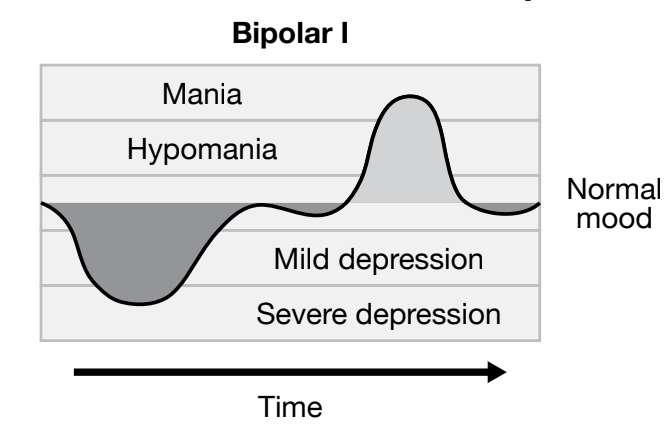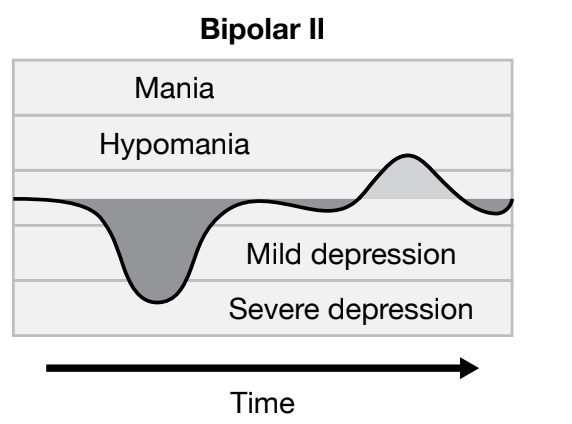Unit 5 Part 3 ID Terms: Types of Psychological Disorders
1/34
Earn XP
Description and Tags
Definitions from AMSCO Book
Name | Mastery | Learn | Test | Matching | Spaced |
|---|
No study sessions yet.
35 Terms
Schizophrenia
The most profound and devastating of all mental disorders, and it is the most prevalent disorder among all psychoses. Severe mental disorder characterized by disturbances in thought processes, perceptions, emotional regulation, and behavior. Common symptoms include hallucinations (hearing or seeing things that aren’t there), delusions (false beliefs), disorganized speech or thinking, and difficulty with motivation and daily functioning.
Psychosis
Refers to any disorder in which the affected person has lost contact with reality.
Positive symptoms
The presence of abnormal behaviors or experiences that are added to a person’s normal functioning. (Addition)
Negative symptoms
Refer to those with a marked decrease of normal functions. (Reduction)
Diminished emotional expression
A negative symptom of schizophrenia, where a person shows less facial expression, gestures, or vocal tone. It means the individual may appear less emotionally responsive or may not express feelings as strongly as others. This can make it harder for others to interpret the person's emotions and create difficulties in social interactions.
Delusions
The persistence of false beliefs, usually held by affected individuals as ideas about themselves in relation to the world around them.
Hallucinations
Sensory experiences that occur without any external sensory stimuli, meaning the individual is experiencing something that actually isn’t there. They are involuntary and cannot be controlled by the individual but are experienced as real as any other normal sensory perception.
Flat affect
Refers to a severe reduction in emotional expression. Individuals with flat affect show little or no facial expression, tone of voice, or gestures, even in situations that would typically provoke strong emotions.
Schizoaffective disorder
Is essentially schizophrenia plus periodic symptoms of disordered affect or mood. An individual diagnosed with this disorder will not only display two or more of the five psychosis- related symptoms described above but will also present a major mood episode of either pervasive depression or mania.
Bipolar I
Is a mood (or affective) disorder in which an individual had experienced at least one manic episode (mania) as well as episodes of major depression.

Major depression
A mental health condition characterized by persistent feelings of sadness, hopelessness, and a lack of interest or pleasure in activities that were once enjoyable.
Mania
A state of abnormally elevated mood and intensely high energy that disrupts daily life.
Manic episode
A period of abnormally high mood and energy; often characterized as either excessively euphoric, like “feeling on top of the world,” or extremely irritable and dysphoric, experiencing profound unease. People may also experience feelings of grandiosity and begin many projects that are often beyond their skills or talents. They may also require significantly less sleep.
Flight of ideas
People with bipolar I may display this in speech because their thoughts may race faster than they can express coherently.
Hypomania
An individual with bipolar I may also this, a condition that is similar to mania but less severe. It is characterized by a pattern of episodes alternating between hypomania and major depression.
Bipolar II
An individual would have experienced a hypomanic episode but never a manic one.

Cyclothymic disorder
A mood disorder that involves elevated moods similar to hypomania but not as severe. The depressive episodes in this disorder are also not as severe. Chronic, quick-cycling mood changes that are less severe than bipolar disorder
Depressive disorders
Significant feelings of sadness, emptiness, or irritability that are accompanied by somatic and cognitive disruptions that significantly affect daily function. There are 8 types; The three most common disorders are disruptive mood dysregulation disorder, major depressive disorder, and persistent depressive disorder.
Disruptive mood dysregulation disorder (DMDD)
A childhood psychological condition characterized by extreme irritability, anger, and intense and sometimes frequent temper outbursts.
Major depressive disorder
Also known as unipolar depression, involves severe symptoms such as fatigue, sustained depressed mood, diminished interest or pleasure in activities, decreased appetite, weight loss, sleep disturbances, feelings of worthlessness, guilt, diminished ability to concentrate, and persistent thoughts of death or suicide. Combination of symptoms that interfere with the ability to work, study, sleep, eat, and enjoy once pleasurable activities.
Persistent depressive disorder
A depressed mood that has lasted for at least two years. It is considered a milder form of depression with no suicidal thoughts. Someone with this disorder may experience two or more of the characteristic symptoms: poor appetite or overeating, sleep disturbances, fatigue, low self-esteem, poor concentration, feelings of hopelessness, and a lack of interest in activities they had previously found interesting. (dysthymia)
Personality disorder
People with personality issues that are so problematic, abnormal, and enduring that they lead to distress or impaired interactions with others suffer from this disorder. Characterized by enduring patterns of internal experiences & behavior that are deviant from one’s culture; pervasive & inflexible; begin in adolescence/early adulthood; stable over time and lead to personal distress or discomfort.
Cluster A
“Odd, Suspicious, and Eccentric” disorders include disorders that show patterns of paranoia, social isolation, cognitive or perceptual distortions, and eccentric behaviors.
Paranoid personality disorder
It is a pattern of distrust and suspiciousness about other people’s motives, and usually those motives are considered malevolent.
Cluster B
“Dramatic, Emotional, Erratic” disorders, as their name implies, are disorders that cause significant disruption and even harm to self and others.
Borderline personality disorder
Marked by a significant and disruptive pattern of instability in interpersonal relationships, mood, self-image, and impulse control. Characterized by instability in relationships and moods. Tend to have a poor self-image and are very impulsive and unpredictable.
Histrionic personality disorder/Narcissistic personality disorder
Attention-seeking and self-centeredness are characteristic of these disorders.
Antisocial personality disorder (APD)
Most frequently associated with criminal behavior. A person with this disorder often is unable to feel any empathy or guilt, and that inability leads to a pattern of disregard for the rights and well-being of others and rampant manipulative behavior.
Cluster C
“Anxious and Fearful” disorders include avoidant, dependent, and obsessive-compulsive personality disorders.
Obsessive-compulsive personality disorder
Involves a disruptive preoccupation with orderliness, perfectionism, and personal and interpersonal control.
Neurocognitive disorders (NCD)
Refer to a group of disorders in which the primary problem is in cognitive function, but it is an acquired disorder rather than a developmental one.
Alzheimer’s disease
Progressive neurodegenerative disorder that causes memory loss, confusion, and changes in behavior.
Lewy body-related dementia
Causes neurocognitive impairment but also includes hallucinations as a symptom. Protein deposits
Delirium
The central features include cognitive dysfunction in attention or awareness, limited attention span, and confusion. Additionally, memory deficit, disorientation, and perceptual disturbance may be caused by a direct physiological or medical condition; tends to be transient—it comes and goes.
Psychology student syndrome
A condition mentioned in the context of the DSM-5, where students studying psychology may start to worry that they have a particular psychological disorder after learning about its symptoms. This happens when certain symptoms described in the course material resonate with the student, leading them to wonder if they might have that disorder. However, these feelings are typically temporary and may not reflect an actual mental health issue.